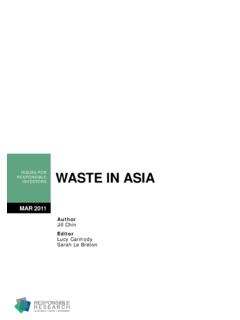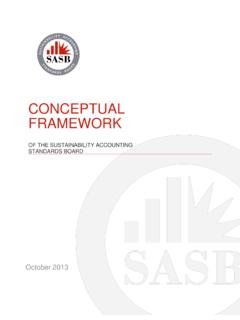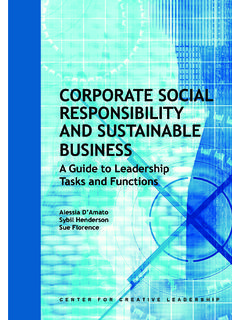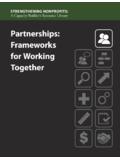Transcription of DBS GREEN BOND - Sustainalytics
1 DBS GREEN bond FRAMEWORK FRAMEWORK OVERVIEW AND SECOND OPINION BY Sustainalytics July 13, 2017 Trisha Taneja (Toronto) Associate, Advisory Services (+1) 647 317 3695 Vikram Puppala Catalina Secreteanu (Sydney) Associate Director, Institutional Relations (+61) 2 8015 5651 Vikram Puppala Manager, Charlotte Peyraud (New York) Senior Associate, Institutional Relations (+1) 646 518 0184 Vikram Puppala Manager, Advisory Services (Toronto) Sustainalytics 2017 2 TABLE OF CONTENTS FRAMEWORK OVERVIEW AND SECOND OPINION BY Sustainalytics 1 1. Introduction 3 2. Overview of Issuer 3 3. Framework overview 4 Use of Proceeds 4 Project Evaluation and Selection Process 6 Management of Proceeds 7 Reporting 7 4 Sustainalytics OPINION 9 Section 1: Sustainability Performance of the Issuer 9 Section 2: Impact of Use of Proceeds 10 Section 3: Sustainalytics Opinion on the DBS GREEN bond Framework 11 Conclusion 12 APPENDICES 13 Appendix 1: Comparison of Real Estate Certification Schemes 13 Appendix 2: GREEN bond Programme External Review Form 15 Sustainalytics 22 Sustainalytics 2017 3 1.
2 INTRODUCTION DBS (comprising DBS Group Holdings Ltd and its subsidiaries) has developed a GREEN bond Framework (Framework) under which it is considering to issue multiple GREEN bonds. DBS has engaged Sustainalytics to provide a second opinion on the Framework and the Framework s environmental credentials. As part of this engagement, Sustainalytics held conversations with various members of DBS management team to understand the sustainability impact of DBS business processes and the planned use of proceeds under the Framework. Sustainalytics also reviewed relevant public and internal documents. This document contains two sections: Framework Overview summary of DBS GREEN bond Framework; and Sustainalytics Opinion an opinion on the Framework.
3 2. OVERVIEW OF ISSUER DBS is a financial services group in Asia, with over 280 branches across 18 markets. Headquartered and listed in Singapore, DBS has a growing presence in the three key Asian axes of growth: Greater China, Southeast Asia and South Asia. The Group provides a full range of services in consumer, SME and corporate banking. DBS states that it has a sustainability strategy that spans its entire value chain. As disclosed in its 2016 Annual Report1, the Group has enhanced its responsible lending policies, integrated climate change considerations into its strategy and engaged local and international stakeholders to advance sustainability and climate change reporting.
4 Its sustainability strategy is composed of four pillars2: (1) Responsible Banking; (2) Responsible Corporate Citizenship; (3) Creating Social Impact; and (4) being an Employer of Choice. As per its website, DBS also states that it has chosen to focus on four specific Sustainable Development Goals (SDGs)3 SDG 7: Affordable and Clean Energy, SDG 8: Decent Work and Economic Growth, SDG 12: Responsible Consumption and Production, and SDG 13: Climate Action. According to DBS, this focus takes into account DBS unique heritage, strategy, the markets it operates in and its businesses. To further its four-pronged sustainability strategy, and its commitment to advancing the SDGs, DBS is planning to issue GREEN bonds to finance environmentally impactful assets and projects across the markets it operates in.
5 1 2 3 Sustainalytics 2017 4 3. FRAMEWORK OVERVIEW The Framework sets out the guidelines for DBS GREEN bond issuances in accordance with the four core components of the GREEN bond Principles (GBP)4 issued by the International Capital Market Association (ICMA): use of proceeds; process for project evaluation and selection; management of proceeds; and reporting. Use of Proceeds The proceeds from DBS GREEN bond issuances (Proceeds) will be used to finance or refinance new or existing GREEN assets/projects which meet the criteria outlined below (Eligibility Criteria). Where relevant, the Proceeds may also be used to finance companies that derive 90% or more of their revenues from GREEN assets/projects which meet the Eligibility Criteria.
6 Eligibility Criteria 1. GREEN BUILDINGS a. Purchase, construction or renovation of commercial and residential buildings that meet recognised standards, such as Singapore Building and Construction Authority (BCA) GREEN Mark (Gold Plus and above), Hong Kong BEAM Plus (Gold and above), LEED (Gold and above), or China Three Star GREEN Building Evaluation Standard (Three Star rating). 2. SUSTAINABLE TRANSPORTATION a. Public Transportation: i. Operation of low-emission mass transportation systems such as rail, metros, trams, cable cars, electric/hybrid buses, and bicycle schemes. ii. Production of public transport vehicles, such as buses, passenger trains, and ferries. iii. Development of infrastructure for mass transportation, such as railway lines and electric lines.
7 This also includes development of supporting infrastructure such as signalling and communication technologies, as well as general information technology upgrades. b. Clean, private, light-duty vehicles: i. Production and distribution of clean or environmentally-friendly vehicles. ii. Purchase of clean vehicles by consumers. c. Clean, private, electric or hybrid heavy-goods vehicles: i. Production of clean or environmentally-friendly vehicles. ii. Purchase of clean vehicles by consumers. Clean vehicles are electric and hybrid vehicles that have been classified as A1 or A2 under the Vehicular Emissions Scheme (VES) as determined by the Land Transport Authority of Singapore (or such other equivalent ratings in other countries).
8 4 Sustainalytics 2017 5 3. RENEWABLE ENERGY a. Construction and operation of wind and solar infrastructure. b. Production of components destined for wind and solar projects. c. Purchase of wind and solar energy products by consumers. d. Construction and operation of run-of-river hydro projects <25 MW. e. Construction, production, operation and consumer purchase of other generally accepted sources of renewable energy as recognised by the International Renewable Energy Agency (IRENA)5. 4. ENERGY EFFICIENCY a. Development and production of products or technologies that reduce industrial energy consumption, such as improved chillers, improved lighting technology and enhanced battery capacity.
9 B. Purchase and installation of such products or technologies by consumers. 5. WASTE MANAGEMENT a. Construction, operation or upgrade of recycling infrastructure, including waste minimisation, filtering, management, recycling and reuse. b. Construction, operation or upgrade of waste-to-energy power plants that use environmentally-friendly technologies, such as methane capturing. 6. CLIMATE CHANGE ADAPTATION a. Development, production and purchase/installation of products or technologies that enable adaptation to climate change, including information support systems such as climate observation and early warning systems. b. Construction, investment or operation of adaptation related-projects that contribute to a reduction in vulnerability to climate change.
10 The Proceeds may also be used to fund the following eligible assets/projects within DBS own operations: RENEWABLE ENERGY - Installation of solar panels or other renewable energy equipment. ENERGY EFFICIENCY- Purchase and installation of products or technologies that reduce energy consumption, such as improved lighting technology and enhanced battery capacity. WASTE MANAGEMENT- Purchase and installation of recycling infrastructure, including waste minimisation, filtering, management, recycling and reuse. 5 Sustainalytics 2017 6 Exclusionary Criteria DBS has developed a list of exclusionary criteria on the use of the Proceeds. In this regard, DBS commits to not knowingly using the Proceeds for the financing of assets/projects included in the exclusionary criteria.








